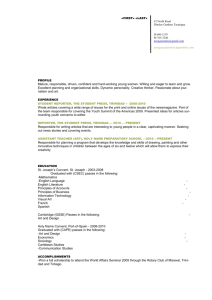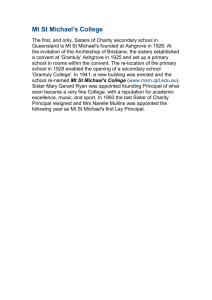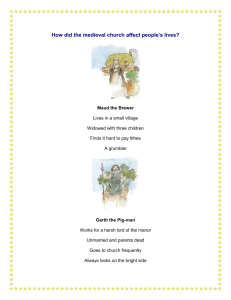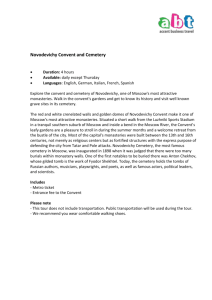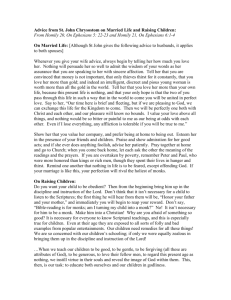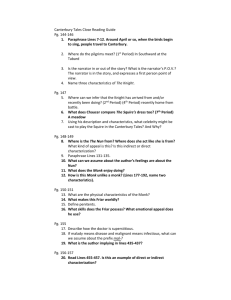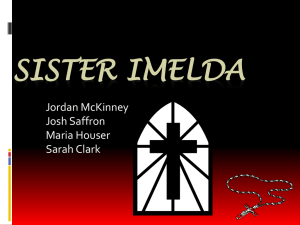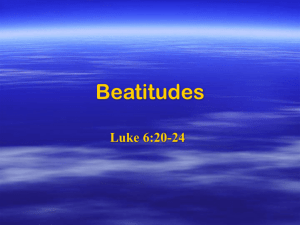Language-Arts Learning, Memory, Analysis
advertisement
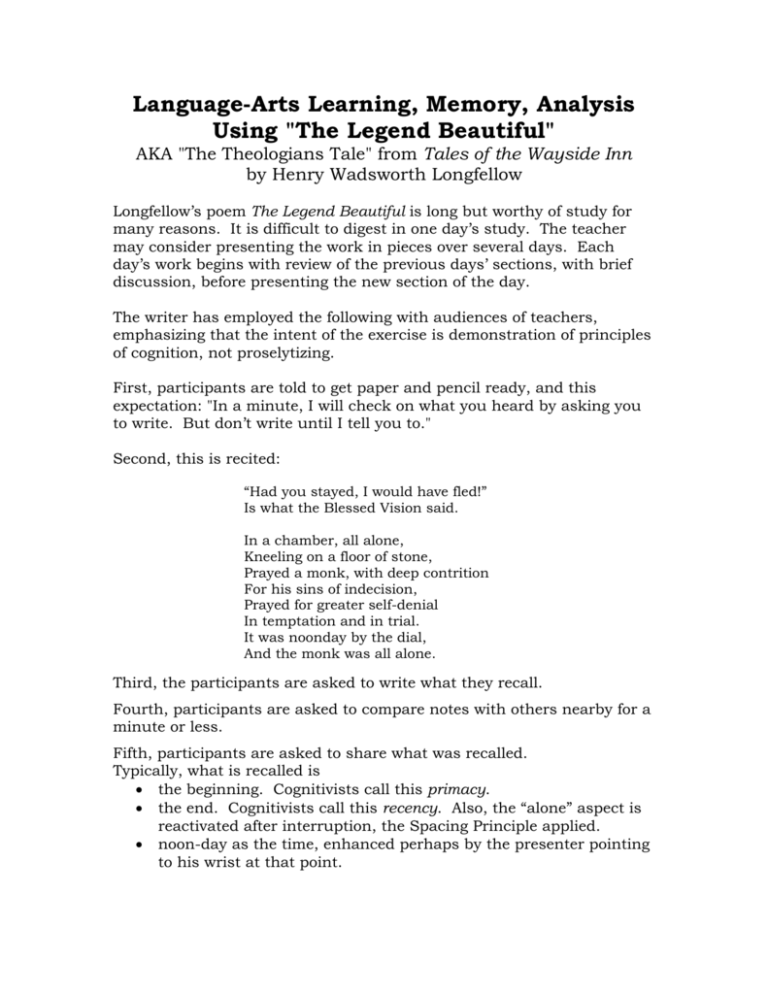
Language-Arts Learning, Memory, Analysis Using "The Legend Beautiful" AKA "The Theologians Tale" from Tales of the Wayside Inn by Henry Wadsworth Longfellow Longfellow’s poem The Legend Beautiful is long but worthy of study for many reasons. It is difficult to digest in one day’s study. The teacher may consider presenting the work in pieces over several days. Each day’s work begins with review of the previous days’ sections, with brief discussion, before presenting the new section of the day. The writer has employed the following with audiences of teachers, emphasizing that the intent of the exercise is demonstration of principles of cognition, not proselytizing. First, participants are told to get paper and pencil ready, and this expectation: "In a minute, I will check on what you heard by asking you to write. But don’t write until I tell you to." Second, this is recited: “Had you stayed, I would have fled!” Is what the Blessed Vision said. In a chamber, all alone, Kneeling on a floor of stone, Prayed a monk, with deep contrition For his sins of indecision, Prayed for greater self-denial In temptation and in trial. It was noonday by the dial, And the monk was all alone. Third, the participants are asked to write what they recall. Fourth, participants are asked to compare notes with others nearby for a minute or less. Fifth, participants are asked to share what was recalled. Typically, what is recalled is the beginning. Cognitivists call this primacy. the end. Cognitivists call this recency. Also, the “alone” aspect is reactivated after interruption, the Spacing Principle applied. noon-day as the time, enhanced perhaps by the presenter pointing to his wrist at that point. Sixth, a written copy of the recitation is shown or distributed, so that recall of what was heard can be tidied. Also, the form is now different -the passage has been heard, written about, spoken about, and now read. Processing is fairly thorough. Seventh, participants are asked to speculate concerning what is going to happen next. The most frequent response is, “He isn’t going to be alone.” Eighth, and even if teachers aren’t Language Arts teachers, they or students are next asked to identify literary elements and devices. Most can identify the first two lines as being a “teaser”, often used in television shows to hook the audience before identification of the show, regular cast, guest stars, and the initial onslaught of commercials. If the teaser isn’t interesting, the remote control searches for more interesting teasers. The short passage reminds the teacher that special vocabulary words might be identified and defined. “Contrition” means remorse. A list of literary devices or elements might be provided. Example list: A. Setting B. Character development C. Action D. Parallels E. Contrasts F. Foreshadowing G. Theme H. Teaser? At this time, points can be made regarding information processing. What has the teacher (presenter) done to help insure that the recitation hasn’t simply been heard and processed shallowly? Along with those mentioned above, the initial request to get writing material ready is a request for action, which required attention. In the presentation to teachers, the subject should be changed for 15-30 minutes (deactivation), before The Legend Beautiful is taken up again. In the classroom, the second part of what was started the previous day is now reviewed and extended. More of The Legend Beautiful will wait for the next day, after students have slept on the first experience (deactivation and digestion). After deactivation, the initial experience is reviewed, including another recitation of the first passage, review of devices, predictions, etc. Then the next passage is recited: Suddenly, as if it lightened, Unexpected splendor brightened All within him and without him In his narrow cell of stone. And he saw the Blessed Vision Of Our Lord, with light elysian Like a vesture wrapped around Him Like a garment ‘round Him thrown. After hearing, the audience or class again writes, discusses content, reads, predicts, and considers literary merits. Then, for the first time, participants are asked to examine the two days’ sections for connections and contrasts. In this manner, the content of the poem and the literary aspects are digested much more than by any one-day experience. Anticipation of what-will-happen-next (and other investment) multiplies as students move further into the work. This writer’s sixth-grade teacher read this poem in its entirety each day for several consecutive days after lunch. This was siesta time anyway, particularly since an injurious version of Kill-The-Guy-With-The-Ball followed each lunch, and all of the boys in that grade were exhausted by that time. Not as much processing happened, therefore, by her class, as what is merited by this superb poem. This writer paid more attention on the last day, and saw why Mrs. Smith had kept at it. Adult life prompted memorization, aided by the story elements and the rhyming aspects, despite the somewhat irregular rhyming scheme. A childhood story, “Spotty the Turtle Wins a Race”, can be read to and by classes in three sections, possibly covered similarly over as many days. Suggested questions are a part of this web site also. The story, from Old Mother West Wind by Thornton Burgess, is an elaborate rendering of the Aesop Fable, with more animal science but at the expense of the good Aesop moral. “Had you stayed, I would have fled!” Is what the Blessed Vision said. In a chamber, all alone, Kneeling on a floor of stone, Prayed a monk, with deep contrition For his sins of indecision, Prayed for greater self-denial In temptation and in trial. It was noonday by the dial, And the monk was all alone. Suddenly, as if it lightened, Unexpected splendor brightened All within him and without him In his narrow cell of stone. And he saw the Blessed Vision Of Our Lord, with light elysian Like a vesture wrapped around Him Like a garment ‘round Him thrown. Not as crucified and slain Not in agonies of pain Not with bleeding hands and feet Did the monk his Master see But as in the village street In the home and harvest-field Halt and blind and lame He healed When He walked in Galilee In an attitude imploring, Hands upon his bosom crossed, Wondering, worshipping, adoring, Knelt the monk in rapture lost. “Lord,” he prayed, “in heaven that reignest, Who am I, that thus Thou deignest To reveal Thyself to me? Who am I, that from the center Of Thy glory, Thou should enter This poor cell, my guest to be?” Then, amid his exaltation, Loud the convent bell appalling, From its belfry, calling, calling, Rang through court and corridor With persistent iteration He had never heard before. It was now the appointed hour, When, alike in shine or shower, Winter’s cold or summer’s heat, To the convent portals came All the halt and blind and lame All the beggars of the street For their daily dole of food Dealt them by the brotherhood And their almoner was he Who, now on his bended knee, Rapt in silent ecstasy Saw the Vision and the splendor. Deep distress and hesitation Mingled with his adoration. Should he go, or should he stay? Should he leave the poor to wait, Hungry at the convent gate ‘Til the Vision passed away? Should he slight his radiant Guest Slight this Visitant celestial For a crowd of ragged bestial Beggars at the convent gate? Would the Vision there remain? Would the Vision come again? Then, a voice within his breast Whispered audible and clear As if to the outward ear: “Do thy duty; that is best. Leave unto thy Lord the rest.” Straightway to his feet he started And with longing look intent Upon the Blessed Vision, bent, Slowly from his cell departed, Slowly on his errand went. At the gate, the poor were waiting Looking through the iron grating With that terror in the eyes That is only seen in those Who, amid their wants and woes Hear the sounds of doors that close And of feet that pass them by Grown familiar with disfavor Grown familiar with the flavor Of the bread by which men die. But, today (they know not why) Like the gate of Paradise Seems the convent door to rise, Like a sacrament divine Seems to them their bread and wine. In his heart, the monk was praying, Thinking of the homeless poor, What they suffer and endure, What we see not, what we see And the inner voice was saying “Whatsoever thing thou doest To the least of Mine and lowest That thou doest unto Me.” Unto Me! But had the Vision Come to him in beggar’s clothing Come a mendicant imploring Would he then have knelt adoring Or have listened with derision And have turned away with loathing? -- The Legend Beautiful The Theologian’s Tale Longfellow, Tales of the Wayside Inn with small adaptations Thus his conscience put the question Full of troublesome suggestion ‘Til at length with hurried pace Toward his cell he turned his face And beheld the convent bright With a supernatural light Like a luminous cloud expanding Over floor and wall and ceiling But he paused with awestruck feeling At the threshold of his door For the Vision still was standing Where he’d left Him there before When the convent bell, appalling, From its belfry, calling, calling, Summoned him to feed the poor. Through the long hour intervening It has waited his return And he felt his bosom burn Comprehending all the meaning When the Blessed Vision said, “Had you stayed, I would have fled.”

